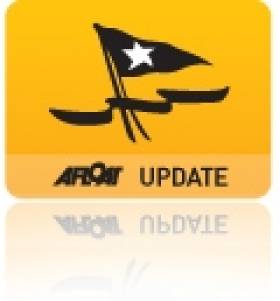Displaying items by tag: Mermaid Nationals
Rush Mermaid Championships Hit By Strong Winds
#mermaid – Strong winds gusting to 35–knots forced the cancellation of the first race of the Mermaid Sailing Association National Championships 2014 at Rush Sailing Club yesterday.
The annual event for the three man dinghy class, which typically starts with the Rockabill Trophy as a first race prize was scrubbed as strong winds hit the north Dublin venue. Racing continues this morning (more strong winds are forecast) and runs until 15th August.
Carthy Wins Opening Race of Mermaid Week
All age groups are sailing from pre-teen to some in their eighties. There are five pairs for brothers helming ten competing boats - Enda and Anthony Weldon from Rush, James and Vincent McCormack from Foynes, James's sons Darragh and Mark McCormack, Jim and Anthony Carthy from Rush and veterans Shay and Martin O'Toole from Skerries. There are also many husband/wife crews.
Frankie Browne of Skerries in Cara II (No. 135) got a great start and built on his lead during the first beat and again on the first run. He lead for the first eight legs, but on the ninth and last leg he failed to cover effectively and was beaten by Jim Carthy in No. 123 Vee (Rush) in 1st and Jim Dempsey in No. 183 Wannago (Skerries).
The 2009 Champion, Paddy Dillon (131 Wild Wind, Rush) was a solid fourth, with Anthony Carthy (188 Innocence, Rush) in fifth. Derek Joyce (187 Zuleika, Wexford) who had been in the top three also lost out on the last beat and came in sixth.
The winner of the "Daphne" fleet (equivalent of Silver Fleet) was Alan Berg of Rush, sailing No 93 Swallow. The winner of the "Designer" fleet was Mark Boylan in No. 177 This Is It, sailing a boat his father Joe built and sailed for many years. Best local boat was Vincent McCormack in No 119 Three Chevrons.
Racing today starts at 10:30 with live updates on the Mermaid Week website http://www.dublinbaymermaid.org/foynes2010/index_files/Commentary.htm.
Foynes to Stage Mermaid Championships
Foynes Yacht Club has been chosen to host the Mermaid National Championships. The competition, last hosted in Foynes in 2004, will see almost forty sailing boats of a classic 1950’s design, racing daily for seven days on the estuary waters close to the picturesque and historic port village. The competition brings with it a festival atmosphere, as over a hundred sailors with their families and friends settle in for a week packed with competitive and social activities by day and by night.
A special feature of this year’s competition will be the Family Fun Day which will be held on the Bank Holiday Monday (2nd Aug) and will seek to raise much needed funds for the RNLI. With championship racing finishing early on that day, the club will be thrown open to the public for them to enjoy some fun and frolics both on and off the water. Among other events, a sponsored Mud Splat Obstacle Course Race will make for entertaining viewing and a display from the Coastguard Helicopter is expected.
The club is very pleased to announce that Shannon Foynes Port Company (SFPC) will act as ‘Anchor’ Sponsor for the event. Joint planning activities are well underway to ensure that all activities are run in a safe, efficient and entertaining fashion. The committee and members will now be canvassing financial support from the business community in the Limerick area in an effort to defray the considerable expense to the club of running such a prestigious festival event. In return, sponsors who chose to associate their business with this National Championship will be assured of high exposure of their company name and products, achieved through a range of promotional ideas.
Regular Updates are available on www.foynesyachtclub.com































































